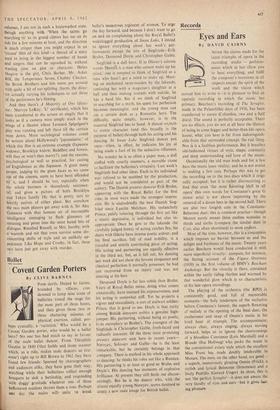Ballet
Covent Garden Porters
By CLIVE BARNES
POOR devils. Duped by fairies, hounded by villains, con- demned to lump nine stone of ballerina round the stage for the most part of three hours, and then given those two or three shattering minutes of physical exertion, called, per- haps cynically, a 'variation.' Who would be a Covent Garden porter, who would be a ballet hero? No one has had much to say in favour of the male ballet dancer. From Th6ophile Gautier in 1840 ('that feeble and inane manner which, as a rule, makes male dancers so tire- some') right up to Bill Brown in 1962 they have found few friends. Spurned by choreographers and audiences alike, they have gone their way, watching while their ballerinas collect enough bouquets to sink a battleship, and responding With doggy gratitude whenever one of those beflowered maidens throws them a rose. Perhaps one day the males will unite to break ballet's monstrous regiment of women. To urge the day forward, and because I don't want to go on and on complaining about the Royal Ballet's waterlogged production of Swan Lake, 1 intend to ignore everything about last week's per- formances except the trio of Siegfrieds—Erik Bruhn, Desmond Doyle, and Christopher Gable.
Siegfried is a dull hero. If in Olivier's solemn words 'Haml& is a man who cannot make up his mind,' one is tempted to think of Siegfried as a man who hasn't got a mind to make up. Meet- ing an enchanted swan-maiden by the lakeside, confusing her with a magician's daughter at a ball and then making amends with suicide, he has a hard life. But if we think of Siegfried as searching for a myth, his quest for perfection becomes meaningful, and the young man can cut a certain dash as a Romantic hero. The difficulty, quite simply, however, is in the n•material Siegfried has to hand. A dancer expects to create character (and this broadly is the purpose of ballet) through both his acting and his dancing. In Swan Lake Siegfried dances just once—when, in effect, he indicates his joy at being made a fool of by the seductive villainess.
No wonder he is so often a paper man, a doll stuffed with courtly manners, a movable crane to facilitate the ballerina's virtuosity. Last week's Siegfrieds had other ideas. Each in his individual' way refused to be snubbed by the production, and would not be considered #s part of the scenery. The Danish premier danseur Erik Bruhn, appearing with the Royal Ballet for the first time, in most ways made the strongest impres- sion. He is undoubtedly the best Danish Sieg- fried since Lauritz Melchior. His melancholy Prince, palely loitering through the first act like a manic depressive, is individual but also in- appropriate. Once he gets to the lakeside the carefully judged frenzy of acting catches fire, his duets with Odette have intense poetic ardour, and his final sacrifice, full of mad nobility, is a forceful and utterly convincing piece of 'acting. His acting and partnering are equally effective in the third act, but, as it fell out, his dancing last week did not show the fervent eloquence and classical perfection it normally possesses; he had just recovered from an injury and was not dancing at his best.
Desmond Doyle is far less subtle than Bruhn. Years of Royal Ballet mime, doing what comes unnaturally, have maimed his expressiveness, and his acting is somewhat stiff. Yet he projects a vigour and masculinity, a sort of stalwart soldier- Prince, that is good to see. Doyle is that rarity among British danseurs nobles a genuine high- jumper. His partnering, without being so poetic, is as exemplary as Bruhn's. The youngest of the Siegfrieds is Christopher Gable, fresh-faced and radiantly innocent. Of the three most promising premier dansenrs seen here in recent years- Nureyev, Soloviev and Gable—he is the least remarkable, but he certainly belongs in that company. There is method in his whole approach to dancing: he thinks his roles out like a Russian. His partnering is at least as good as Bruhn and Doyle's. His dancing has moments of explosive brilliance. At present they still fizzle out discon- certingly. But he is the dancer who, with the almost equally young Nureyev, seems destined to create a new male image for British ballet.


































 Previous page
Previous page